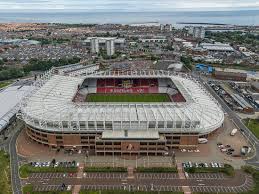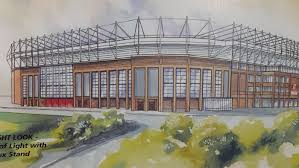The installation of safe standing and the work currently underway to move the ticket office out of Black Cat House and replace it with the relocated club shop are some of the biggest alterations to have been made to the Stadium of Light in recent years.
Back in 1999 though even more significant plans were moving forward, with the news that following a local planning meeting, an extension to the North (Vaux) Stand had been deemed acceptable by council representatives and would be formally ratified in the coming days. Sunderland AFC had been enjoying impressive crowd numbers since moving to the ground two years earlier and were hoping to capitalise on the feelgood factor around the club, with work now expected to commence in the coming months and be ready for the start of the 2000-01 campaign.
News of the scheme had first been released earlier in the year, when the Lads were sat on top of Division One and looking well set for promotion. Drawn up by Glasgow based chartered architects The Miller Partnership, planning application 99/00277/LEG was officially submitted to Sunderland City Council on the 1st of March with the proposal worded thusly; ‘Extension (new upper deck) to north stand of stadium development with associated refreshments and toilets.’ The address was given for Stadium Park was Wreath Quay Road – now known as Millenium Way.
A second prospective application had been lodged at the same time, 99/00278/FUL being for ‘Extension (new upper deck) to south stand of stadium to provide additional 7,232 seats, with associated refreshments and toilets’. Despite this being for what was then known as the Metro FM Stand, the address attached to Stadium Park this time was Vaux Brewery Way, which actually ran behind the opposite end of the ground.
When first outlining the board’s thinking, chairman Bob Murray (yet to be knighted at this point) explained that expanding the Vaux Stand was estimated to cost approximately £5.5 million but would ultimately be self-financing, and that the project was being split into phases so that further seats would only put in based on certain criteria – namely Premiership status, sufficient supporter demand, and in the case of the Metro FM Stand, the arrival of the Metro system on Wearside.
:no_upscale()/cdn.vox-cdn.com/uploads/chorus_asset/file/25501861/20240617_211555.jpg)
The stadium had originally been designed and constructed in such a way that future redevelopment could easily be implemented, and with Peter Reid’s side averaging the fourth largest attendances in the country at the time the club wanted to be ready to go should they feel it appropriate. The final decision, assuming approval was granted, would be made later and of course by the time the first phase was rubberstamped by the local authority the Lads had indeed confirmed they would be going back into the topflight with a record breaking 105 points.
Further work to bring the Stadium of Light up to a total capacity of 63,000 was also mooted, should England’s bid to stage the 2006 FIFA World Cup have been successful, but the Vaux Stand was always going to be the first focus. Once given the go ahead, work soon started on making the necessary arrangements, and a November start date for the development was set once Mowlem were awarded the contract to provide the extension. The firm had previously carried out projects for Tottenham Hotspur, Aston Villa and the Rugby Football Union (at Twickenham Stadium) and were confident of completion to ‘the highest standard’ and on time by the end of July 2000.

Once a site compound had been set up and ground preparation works completed, Mowlem envisaged the more noticeable modifications taking shape in the New Year with tower cranes being brought in. Sections of the existing roof were to be removed from February onwards and steelwork commencing thereafter, with fans affected by temporary entrance arrangements and a lack of protection from the elements allowed to temporarily move to a different part of the ground for matches should they wish.
Arcing round from the Premier Concourse, the new look was expected to increase capacity from 42,300 to 48,300. 2,500 of these spaces were initially set aside for concessionary match day sales with others intended for new season tickets, but the area now houses away fans following a switch made ahead of the 2012-13 campaign. The North Upper will be one of two spots to have rail seating implemented as it continues to evolve, but it was the decision of quarter of a century ago that was to impact the footprint most – and allowed a landmark change to the Sunderland skyline that still remains.
